





































































































































































































































































































































































































































































Dear valued customers,
I spend a fair amount of my time travelling by air every year — much of it for work, but sometimes also family holidays or other personal journeys. Of course, my preference is always Caribbean Airlines — with all the warmth and quality we offer all our passengers.
But we don’t fly to every destination, so when I have to use another airline, I treat every journey as a learning adventure. I am truly never bored when every interaction, service, and feature is relevant to me as CEO of a competitor or comparator.
Here are three things I’ve taken to heart in the last year and have tried to take action around — on behalf of all of you, our passengers.
1) Boarding passes are boring and a missed opportunity. They are such a precious part of your journey and yet are usually — at best — a collection of numbers and a logo.
That’s why, later this year, we will be introducing our Welcome Home Boarding Pass Collection. Reflecting all the cultural, artistic, and design influences that are part of our Welcome Home Caribbean ethos, we believe some people may well want to collect the set! At the very least, we hope you enjoy this little touch of Caribbean colour on your journey.
2) Queueing is hard work, particularly at busy airports. That’s no revelation to anyone. But I find it particularly frustrating if it’s when you’re leaving your home — in my case, Trinidad.
As Trinidad’s Piarco International Airport has gotten busier, so congestion has increased, and sometimes the time it takes to get to departure is not great. So, we’re working closely with the airport authorities to introduce fast-track security services for departing flights at Piarco. This should ease bottlenecks — especially during multiple departures — and make your travel experience start off even more smoothly.
3) I love getting miles. They reward loyalty and offer the prospect of money-saving in the future — or even an unplanned treat sometime. But it helps when earning is straightforward and spending them is too — with plenty of options.
In the second half of 2024, significant improvements are coming to Caribbean Miles. We are transforming the programme so you earn miles based on the amount spent on your flights. This also means:
• lower rates for miles redemption
• better access to reward seats during peak periods
• enhanced benefits for our tier status members
• the option to use partner miles with your RBC Visa co-branded credit card towards your status.
Just a few more reasons to enjoy travelling — when it’s with Caribbean Airlines. There’s going to be even more to come, based mostly not on my travel experiences — but on yours. We always welcome your feedback and suggestions to help us add those extra touches of comfort, ease, and fun.
Thank-you for choosing us. Here’s to a year filled with new horizons, exciting adventures, and the spirit of the Caribbean.

Regards,
Garvin


The Symphony 2023 Limited Edition Rum is an exquisite cask-aged tribute to the enduring legacy of artistry, craftsmanship and elegance that has defined Angostura Rums for generations.
Symphony 2023 is a blended testament to the meticulous curation of rums, carefully crafted using diverse and refined distillation techniques.
Its ethereal aroma reveals subtle toasted wood undertones – an orchestra of dried fruits and vanilla performs a symphony, contributing to the creamy profile.
Symphony captivates the palate with prominent treacle notes, gracefully accompanied by the embrace of rich, toasted oak. Its smooth and velvety texture beckons indulgence, leading to a remarkably enduring finish that leaves a lingering, fruit-infused aftertaste reminiscent of the finest rum experiences.
Each bottle of the spirit – its rich amber hue, kissed by delicate golden undertones – is a masterpiece, embodying the warm spirit of the season in every sip.
AVAILABLE IN TRINIDAD DUTY FREE STORES ALONG WITH ALL OTHER PRODUCTS FROM






42

16 EvEnt buzz
Festivals and events around the region
22 Art buzz
On view: Garden of Humanity (Miami) and the Plural of He (New York)
26 Music & book buzz
Reviews by Nigel Campbell and Shivanee Ramlochan
30 Word of MoutH
Aisha Sylvester on Easter goat and crab racing in Tobago; and Donna Yawching on the Festival de la Trova in Santiago de Cuba
34 snAPsHot
When destiny beckons
This March, Netflix premieres a film on the trailblazing Shirley Chisholm (who was of Barbadian and Guyanese heritage). Playing Chisholm’s Jamaican husband is Trinidad & Tobago’s own
Michael Cherrie. Caroline Taylor reports
38 GrEEn saving caribbean mangroves
Tree-planting, reforestation, and ensuring the integrity of our waterways are all critical to preserving mangroves — the remarkable forests with the power to protect us from the worst effects of climate change. Erline Andrews learns more
42 round triP easter time in the islands
Five regional travel influencers share their favourite things about Easter time across the Caribbean — as told to Shelly-Ann Inniss
52 LAyovEr
Paramaribo, suriname Newcomers to Suriname’s capital are often surprised by its cosmopolitan

52
charms — which you can enjoy on even a brief visit
54 on tHis dAy “one family, the Wide World o’er”
A century ago, the United Kingdom staged a massive colonial exhibition, aimed at being a lavish demonstration of imperial grandeur, might, and “family unity”. But, writes

34

James Ferguson , none of it would turn out quite as organisers hoped
56 PuzzLEs & brAin tEAsErs
Our crossword, spot-the-difference, and other brain teasers
64 PArtinG sHot Easter kite-flying in the islands
An MEP publication
Editor Caroline Taylor
Designer Kevon Webster
Editorial assistant Shelly-Ann Inniss
Production manager Jacqueline Smith
Finance director Joanne Mendes
Publisher Jeremy Taylor
Business development consultant Halcyon Salazar
Business Development Manager, Tobago and International
Evelyn Chung
T: (868) 684–4409
E: evelyn@meppublishers.com
Business Development Manager, Trinidad Tracy Farrag
T: (868) 318–1996
E: tracy@meppublishers.com
Media & Editorial Projects Ltd.
6 Prospect Avenue, Long Circular, Maraval 120111, Trinidad and Tobago
T: (868) 622–3821/6138
E: caribbean-beat@meppublishers.com
Websites: meppublishers.com • caribbean-beat.com
Printed in Trinidad & Tobago by SCRIP-J
Caribbean
Website: www.caribbean-airlines.com

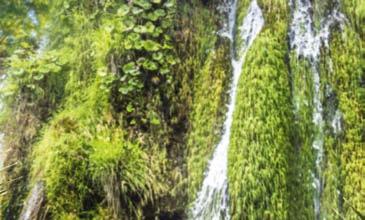












With secluded white sand beaches lapped by sky blue waters, breathtaking natural beauty, stunning biodiversity and authentic Caribbean hospitality, Tobago occupies a special place in the hearts of all who visit – and we can’t wait to welcome you!
Discover Tobago for your perfect escape and prepare to explore our unspoilt, untouched, undiscovered island.

You can find out more at: TobagoBeyond.com #101ReasonsTobago

















Cover Competitive high performance yachts like the J-Class “Velsheda” compete in regattas across the Caribbean during sailing season (November–April)
Photo Nature Picture
Library/Alamy Stock
Photo
Erline Andrews is an award-winning journalist with over 20 years’ experience. She has a master’s degree from Columbia University Graduate School of Journalism, and a particular interest in the environment and conservation.
Nigel Campbell is a Trinidad-based concert producer, music industry analyst, commentator, and reviewer who’s documented Caribbean music in print, on television, and on the Music Matters: the caribbean Edition podcast.
James Ferguson is an Oxford-based publisher, translator and writer with a background in French culture and Caribbean history. He has written several books on Haiti, the Dominican Republic and Jamaica.
Based in Trinidad and part of the caribbean b eat team, Shelly-Ann Inniss is a Barbadian writer; self-appointed tourism ambassador for Barbados; gluten-free baker and founder of Your Gluten-free Companion.
Shivanee Ramlochan , a Trinidadian poet, essayist and book critic, is the author of Everyone knows i am a Haunting. Since 2010, she has blogged about Caribbean and LGBTQI+ literatures at novelniche.net
Aisha Sylvester is a freelance writer and author of the travel blog, Island Girl In-Transit. She lives in Trinidad but spends countless hours exploring Tobago’s beaten paths and hidden gems. Her work has been published in caribbean b eat, d iscover trinidad & tobago, and LoopTT.
Caroline Taylor is a Trinidadian writer, editor, performer, and producer with a particular interest in arts, culture, conservation, and the environment. In addition to caribbean b eat, her work has appeared in various publications, including n ational Geographic and the Guardian (UK).
Donna Yawching is a freelance writer, currently based in Canada. She has written for caribbean b eat since the beginning of time — or at least since the beginning of b eat, whichever came first. Her special interests are travel and culture.






ubbling between the tectonic plates of the past and the future is the molten present — a seething mass of problem and possibility, guided by the precision compass of
unintended consequences.
With an insouciance grounded in technological confidence, we have been hurtling towards the future with the expectation of more and better — oblivious to the gathering storm of the Anthropocene age, with human-induced disasters like climate change and pandemics in a world order unequipped to deliver peace, equity, and justice for all.
This was not what we imagined when we breezed into the 21st century. Seduced by our progress, we expected a braver new world with its alluring promise of millennium development goals fulfilled. Caught now between past and future, the present finds no easy passage. Pay de devil, Jab Jab!
What does the future want of us? There is no mystery here. We know the past too well: the future demands unity of purpose and collective action. As we approach 1.5°C of global warming, Earth’s safety threshold is on the verge of being breached. The consequence of runaway warming would be the destruction of most life on this planet by the end of the century.
The Earth has been brought to this state of emergency within 300 years of the Industrial Revolution through humans cranking up production for export along an ever-expanding global network of trade routes opened up by Europe’s colonial “adventures” across the oceans of the world. In the context of 200,000 years of modern human existence, our dramatic impact on climate breakdown over the last three centuries has been almost instantaneous.
Given the projected rate of planetary heating, the challenge of bringing the global economy and human behaviour into compliance with the requirements of a sustainable planet is, at best, daunting. For the 700-plus islands of the Caribbean, it is existential.
There are no walls or defences in the oceans to protect any of us from rising sea levels or ecological collapse. We are
all trapped in the same greenhouse of gases fuelling global warming, and the consequent onslaught of destructive, extreme weather that challenges even our proudest technological defences against nature’s power.
How cruel the irony that the ghost of the Industrial Revolution — financed from resources extracted by force from our region — should now return to haunt us, as the unforgiving law of unintended consequences exacts its price on the past. Pay de devil.
We will have learned nothing from the Covid-19 pandemic if we do not now fully understand the high price that will be paid, including in lives, when the world lacks the wisdom to stand and work together for our own survival. Our greatest risk is a divided world that weakens us all.
Caribbean people have progressed not by joining the status quo, but by challenging it — whether by our brand of calypso cricket that rattled the foundations of empire; our insistence on the joy of music when music was denied (as with the creation of the steelpan when drumming was banned); our culinary creations concocted from macafouchette, scraps and whatever else was at hand; our intellectual originality as outsiders to mainstream, conventional thought; and our storming the world’s literary citadels, among other things.
With major industrialised countries stalling on climate commitments, including the funding of urgent adaptation programmes in Small Island Developing States (SIDS) around the world, the moment is now for the Caribbean and other SIDS to dynamise the issue and catapult our interest to the top of the global agenda.
The region must seek out partners, join hands and — standing in our own power — demand the urgent release of muchneeded climate funding that has already been pledged, including US$85 billion at COP28 in Dubai three months ago.
The clock is ticking. Pay de devil! Jab Jab.
Sunity Maharaj is the managing director of the Lloyd Best Institute of the West Indies
Essential info about the major festivals and holidays across the region this March and April

Enjoy spoken word, comedy, dance, music, and more at the Bridgetown International Arts Festival (1–31 March), featuring Trinidad & Tobago comedians Lyrix and Stephon John; Mind Fusion, a spoken word trio from Guyana, Trinidad & Tobago, and Switzerland; German actress Sylvia Barth; and a variety of Barbadian artistes.
Carnaval on the Mile (2–3 March) in Coral Gables features “all things Miami”, including live music, children’s entertainment, art and cuisine. Powered by the Kiwanis Club of Little Havana, it’s one of the signature events of Carnaval Miami (running to 6 April), along with the highly anticipated Calle Ocho Music Festival (10 March) — the city’s largest Latin music festival, spanning 15 street blocks in Little Havana.
Sporting action at the prestigious Sandy Lane Gold Cup (2 March); vibes at the Barbados Reggae Festival (28 April–1 May); and the best traditional Bajan fare and entertainment at Oistins Fish Festival (29 March–1 April) add to Barbados’ festive magic.
Get ready to dance as top electronic dance music artistes drop exciting beats at the SXM Music Festival (11–18 March). The dancing continues for SXM Carnival (16 March–30 April).
Breezy, sun-filled days paired with a combination of camaraderie and fierce racing await at the Antigua Superyacht Challenge (11–17 March), Antigua Classic Yacht Regatta (17–22 April), and Antigua Sailing Week (27 April–3 May).



Over in Trinidad, Jazz Artists on the Greens (16 March) promises a slate of unforgettable performances, while literature takes over at the Bocas Lit Fest (25–28 April), where no Caribbean story is too small.
Montserrat’s Irish heritage makes it one of the only places outside Ireland to celebrate St Patrick’s Day (17 March) as a holiday. A freedom run, street parades, hikes, pub crawls, and traditional games are just a bit of the fun.
Phagwa or Holi (25 March) — the cherished Hindu “Festival of Colours, Love and Spring” — is observed in Guyana, Trinidad & Tobago, Suriname, and Jamaica with singing, dancing, and spraying abeer (or abir) on fellow celebrants of all backgrounds.

Easter in Tobago is a special time, filled with egg hunts, kite-flying, bonnet parades, and the season’s favourite activity: goat and crab racing in Buccoo and Mt Pleasant around the long Easter weekend (29 March–1 April). Then later in April, don’t miss the Tobago Jazz Experience
There’s lots of Easter action in Guyana too, where ranchers and cowboys showcase their skills with horses and bulls at the well-loved Rupununi Rodeo. Spectators can engage in various contests like a rigorous tug-of-war, dance-off to country music, watermelon-eating, barrel races, dirtbike races, and lots more excitement. If you prefer water races, the Bartica Easter Regatta is a must!


Some call Jamaica the home of rhythm and sway. The tempo certainly changes during Jamaica Carnival (3–9 April), however, with non-stop soca hits at breakfast parties, fetes, J’ouvert, and the grand parade.
Take in world-class visual storytelling from award-winning regional and international filmmakers at the Miami Film Festival (5–14 April) and Curaçao International Film Festival (10–24 April).



Fancy an open water swim? Try the Nevis to St Kitts Cross Channel Swim (6 April), a 2.5 mile swim across the Narrows — a strait that separates the islands, and traverses where the Caribbean Sea and Atlantic Ocean currents meet.
Indulge in complimentary drinks, discounts on exquisite menus, and opportunities to win prizes including dinner for two during St Lucia Restaurant Week (21–28 April).
Protecting Mother Earth is paramount, and for Earth Day (22 April) and beyond, you can participate in a range of important activities — from beach clean-ups and planting trees, to utilising reusable containers and unplugging electronic devices not in use.
April sees traditional Bahamian sloops take to the water in the National Family Island Regatta (23–27 April) in Exuma, The Bahamas, where they’ll compete to be best in class.
— Event previews by shelly-Ann inniss









the vfW Lot, opa-locka, fL
Curated by James Brazil (Australia), the Ten North Group has acquired two new large-scale sculptures which are now on view in a lushly designed garden in South Florida.yemaya is a six-foot bronze sculpture and the newest work by contemporary Cuban artist Juan Roberto Diago Durruthy (aka “Diago”). Celebrating the Orisha goddess of the living ocean and the mother of all, the sculpture is intended to be in dialogue with the spirits that accompanied African peoples as they crossed the Atlantic Ocean — the Middle Passage.
the cedar Men, meanwhile, comprises five works — each six feet tall — by sculptor and performer Jems Robert Koko Bi from Côte d’Ivoire. They aim to tell the history of humanity through the earth’s first inhabitants in Africa. The artist’s work mixes avant-gardist influences, and the cedar Men pieces — weighing half a tonne each — are sculpted from a single cedar trunk, exploring the forces of nature, ancestors, native land, and exile.
Garden of Humanity is on view through 30 June, 2024.



Photography courtesy Ten North Group

Leslie Lohman Museum, new york, ny
New York City’s Leslie Lohman Museum of Art reopens on 15 March with the Plural of He — an exhibition on the life and work of Trinidadian-American poet, critic, activist, and “godfather of the LGBTQIA+ movement” Colin Robinson (1961–2021).
Curator Andil Gosine — who also curated everything slackens in a wreck (2022) at the Ford Foundation Gallery and kelly sinnapah Mary (2023) at Aicon Contemporary — specially handpicked Devan Shimoyama, Natalie Wood, Leasho Johnson, Ada Patterson, and Llanor Alleyne for commissioned works on the Plural of He, which runs until 21 July and includes additional works by Richard Fung and Amber Williams-King.
The commissioned works are displayed among other archival objects and respond to records of Robinson’s personal history — from Carnival costumes and calypso music to love letters and agitprop.
Notably, a poem titled the Plural of Me in Colin Robinson’s poetry anthology you Have you father Hard Head (published in 2016) encourages mourners to “parcel my cremains like wedding cake, small ribbon-tied boxes for everyone to travel home with ...”
— Previews by caroline taylor and shelly-Ann inniss
Left Godfather’s Return — textile by Amber williamsking and Andil gosine
Below Great Bernadine
Royal Cobo of the Caribbean by Natalie wood
Opposite page Cover art of a new novella by Colin Robinson published for the show
Photography courtesy Andil Gosine/Leslie Lohman Museum




reginald cyntje
Gentle Touch (selfreleased)
On this his seventh album, Reginald Cyntje — pronounced SIN-chee — continues his musical exploration of emotional themes and the intangible through instrumental jazz. With his trombone as lead, this US Virgin Islander explores in a quiet contemplative way the vulnerability of being in love. “Vulnerability is key to authenticity,” he says. “Being vulnerable takes strength, courage, and emotional intelligence. A gentle touch.” That gentle touch is revealed in five tunes on this short EP. They sashay smoothly, and exist within a fine balance of subdued tempo and an earnest reach for moods that showcase languid tropical vibes through bossa nova, reggae, neo-soul, and jazz. Celebration, hope, empathy, the memory of the first time, and growth are the themes highlighted here. Excellent musicianship by his quartet takes centre stage; Allyn Johnson on piano shines. An island perspective on love is always welcomed. Inspiration and reflection are encouraged.
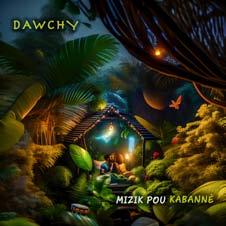
daWchy
Mizik Pou Kabanné (selfreleased)
In any language, this first EP by Guadeloupean singer DaWchY can be the soundtrack to a romantic interlude that deserves repeats. “Mizik Pou Kabanné” loosely translates from Kwéyòl to “music for the bedroom”, and suffice it to say the Caribbean soul music on this production combined with the rich baritone voice of DaWchY make this music for much more than that.
Reggae-dancehall, Antillean rhythms — including gwo ka, R&B/soul, and gospel — span the genres that seamlessly infuse the songs with a universal sound palette. Recorded in both Montpellier, France and his native Guadeloupe, there is an easy accessibility to this music, and an urban sheen that directs the listener to feel it. He tells us that “this project is the story of a beautiful Light behind a half-open door”. And one can sense this to be true. Any language barrier is ignored. The beauty of island music is in the rhythms that bring souls together. bèl

Some 50 years after hiphop’s genesis as a Caribbean-American innovation, these islands continue to produce generations of rappers who spit lyrics and rhymes that engage the ethos of that Bronx summer in 1973. Clever wordplay and syncopation, bombastic tone, metaphor, and iambic pentameter are all present on this new album by “Trinidad & Tobago’s lyricist” Micwise. The island accent is retained as a badge of honour and a kind of identity. The words tell stories that, in this case, focus on inner ideas, personal animus, and push-back on local nihilism and cynicism. He raps: rappin’ in trini, that ... is illogical / is what they told me and my crew that it’s mission impossible / said it’s an American hustle, you need to get out. That sense of dread displays the oftenharsh realities of island life. The Caribbean brain drain over decades has decimated the islands of Creole genius, but these artists who remain represent hope and possibilities. This album does too.

The well that is the source of Stephen Marley’s continuing reggae career springs eternal. Any expected return to his father’s catalogue guarantees legacy surrounding the Marley name, but this eight-time Grammy winner is determined not to be a clone. The 15 songs on the album act as a kind of lo-fi acoustic reassessment, an autobiography perhaps, of a music and its maker. fast forward to 1981, my dad moved on and so did i / inside i kept his songs alive, so they say / i’m an old soul living in the body of a nine-year-old / i guess i have been here before ... It’s a refrain that captures the spirit of this album that has crossover potential beyond reggae. Collaborations with other reggae stars (his brothers Damian and Ziggy, and Buju Banton) and rock and roll icons (Eric Clapton and Grateful Dead founder Bob Weir), to covers of eclectic material by Frank Sinatra, The Beatles, Carlos Santana, and Ray Charles — yes, and Bob too — give the album a patina of magnitude.










Reimagine
possibilities for growth and success at your next meeting. Engage
team at Hyatt Regency Trinidad in one of our many spaces equipped with technology-driven hybrid options. Let us customize your options to maximise the experience for your Group, Meeting or Event. Enjoy world class facilities, fine dining on the waterfront or a spa day. For enquiries email trirt.rfp@hyatt.com.


We are the crisis by
Cadwell Turnbull (Black-stone Publishing, 322 pp, ISBN 9781982603755)
In this second instalment of a high-stakes speculative fiction series, the convergence saga, monsters continue to walk among us: some of them may even wear human faces. Turnbull, who was raised in St Thomas, US Virgin Islands, expands on the alreadycomplex world of interspecies contact he created in his debut, no Gods, no Monsters. Perfectly pitched to mirror the stressors and grief-inducing calamities of our Anthropocene, We Are the crisis tackles grand-scale existential questions alongside touching domestic concerns. The author is particularly adept at framing the events of this sequel in malleable temporal terms, with narratives that pitch forward and backward through time. Peering into the politics of hatred, while striving to show how coexistence might be truly tested in the decades to come, this novel teaches spectacular truths, liberally adorned with horror and fantasy storytelling power.
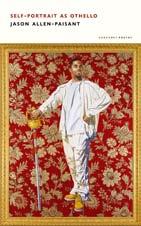
self-Portrait as othello
by Jason Allen-Paisant (Carcanet Press, 80 pp,ISBN 9781800173101)
Winner of both the Forward Prize for Best Collection and the TS Eliot Prize, Jamaican poet Jason Allen Paisant’s second collection is a masterwork in polyvocality. The poet plucks Shakespeare’s infamous Moor of Venice from his classical pages, asking, “What fuller and deeper inhabitations of selfhood reside in this person, so maligned for his Blackness?” The resulting poems are emanations of both imagined and lived experience, calling on prodigious research and personal marrow. If there is a sense that Allen-Paisant is bleeding on the page, as many poets are oft-accused, this is a deliberate and sensory application of that lifeforce: a mapping of Black British masculinities that intersect with rivers of immigrant strife; elitist educations; racially coded carnalities; loss at a molecular level. Through it all, the narrative splendour of self-Portrait as othello moves gracefully, with sharpest intent.

elektrik: caribbean Writing
(Two Lines Press, 166 pp, ISBN 9781949641509)
The voices of eight female authors from Haiti, Martinique, and Guadeloupe occupy this anthology: Gaël Octavia; Fabienne Kanor; Marie-Célie Agnant; Kettly Mars; Suzanne Dracius; Mireille Jean-Gilles; Adlyne Bonhomme; Gerty Dambury. Elektrik is an ensuing celebration of Francophone Caribbean writing that is most attendant to voicing the unsung, to upending prevalent patriarchies, and to exploring women’s survival unstintingly, without apology. Eighth in the publisher’s Calico series, which presents translated work from globally underheard demographics, this gathering of non-fiction, prose, and poetry asks: where are the borders of our shared Caribbean space? Pushing subversively against gendered limitations, the writing herein glimmers with the unmistakeable shine of truth-telling, devoid of any compromise. As Dambury’s “Defiant Islands” invokes: i am in exile from an unborn country. / i choose to stride across a fiction. / the island i hope for is a hidden dream.

uprooting by Marchelle Farrell (Canongate Books, 288 pp, ISBN 9781838858674)
How does an English garden grow? For Trinidadian psychiatrist and psychotherapist Marchelle Farrell, whose youth was characterised by her island’s verdant lushness, the answer might have astonished her: with difficulty and wintry hardships. Yet in uprooting, Farrell’s Nan Shepherd Prize-winning memoir, persistence pays off from tunnelling deep in inhospitable earth. Farrell’s prose is as generous as it is descriptive, summoning childhood romps alongside adult microaggressions with a uniform intentionality: to paint a full, often-troubling portrait of a life lived at sometimes competing intensities. This debut teems with a resultant aliveness, in service to the reality that no single person can be captured or pinned down by the categorical. Farrell is both mother and maker, wife and dreamer, scientist and gardener, and she inhabits these stations with both vexed and gentle thoughtfulness. uprooting presents her to the reader in leafy wonder.



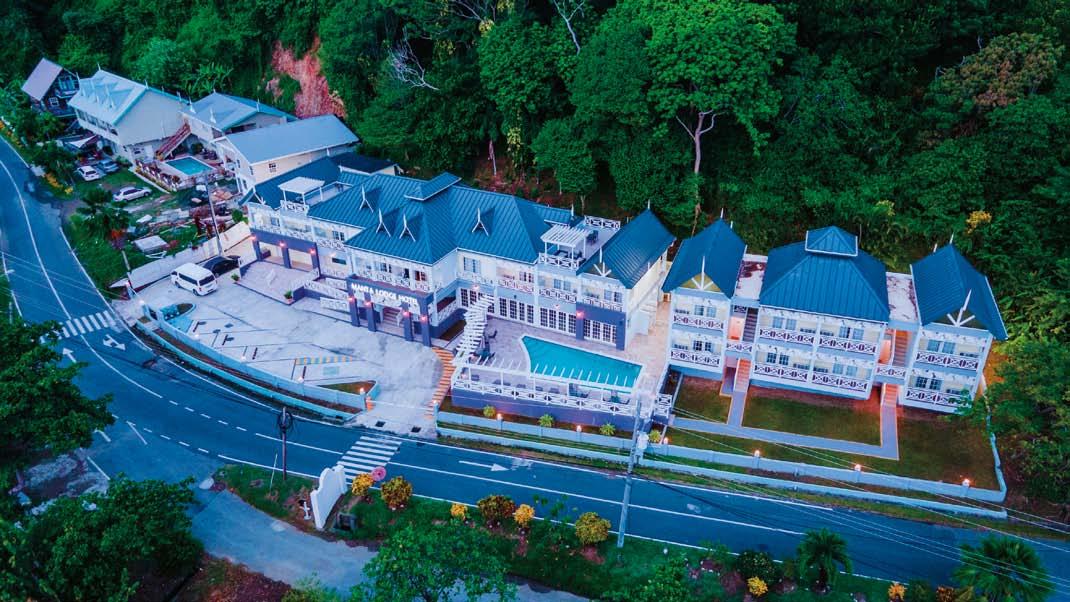





Aisha Sylvester tells us why
Photography courtesy Tobago Tourism Agency Ltd

If Easter weekend finds you in Tobago, there are myriad activities to enjoy — but only one is so iconic, so extraordinary, that it absolutely cannot be missed: the annual goat and crab races.
Hosted in the colourful village of Buccoo on the Caribbean coast, the undeniably quirky and unconventional spectacle of sprinting goats has served as the climax to the destination’s Easter observances for almost a century. Crab-racing was added to the mix more recently, for good (somewhat comical) measure.
Goat-racing emerged as the “poor man’s version” of horse-racing, with humble beginnings in the early 1900s. Since then, it has evolved into one of
Tobago’s most recognisable cultural calling cards — warranting the unofficial extension of the traditional four-day long weekend by an extra day, known as “Easter Tuesday”.
Its elevation from the unpaved village streets to a state-of-the-art track at the Buccoo Integrated Facility is testament to just how embedded this activity is in Tobago’s DNA. Not to mention, the annual pilgrimage of throngs of locals and visitors to the otherwise sleepy seaside hamlet serves to reinforce its significance to the island’s tourism product.
If you find yourself among the thousands descending upon Buccoo on Easter Tuesday, rest assured you’re in for a truly one-of-a-kind experience. Nothing can

fully prepare you for the sight of man and (miniature) beast dashing down the track, tethered by exactly nine feet of rope.
Try not to blink, because the races end in a flash — with the sound of thundering hooves and feet drowned out by the relentless clamour of cheering onlookers rooting for one pair or the other.
And make no mistake: once the starting gates open and the dynamic duos take off, it’s immediately clear that these are no ordinary goats, nor are their jockeys your run-of-the-mill sprinters, and winning isn’t something that happens overnight. Both humans and animals undergo months of intense training, and the goats are placed on strict diets in order to optimise their performance.
To make the most of the experience, getting there early is a must. Front-row
bleacher seats are prime real estate, but the railings bordering the track get you so close to the action you can feel the ground shake as the contenders race by.
For this writer, though, the best spot in the house is at the very end of the track, facing the gates. From this vantage point, you can clearly identify the jockeys who have successfully nurtured a symbiotic relationship with their goat versus the ones who lack the coordination and timing to decimate the competition.
After you’ve had your fill of the caprine athletics, crab-racing allows you to get involved in the activities — no extensive training or diets required. Fair warning, though: while this particular activity may not demand great preparation or discipline, a healthy dose of patience and a sense of humour is beneficial if you


attempt to guide these unruly crustaceans toward the finish line.
The event is about much more than racing, though. Spectators are enveloped in a community-wide ritual filled with food, culture, music, and all-around merriment. Against the picturesque backdrop of unspoilt Buccoo Bay (you can enjoy horse-riding tours here too!), vendors line the streets pedalling everything from delectable local dishes to vibrant crafts and clothing.
All in all, it’s easy to see why this unique festival has cemented its position as the main attraction on Tobago’s Easter calendar of events. Don’t miss it if you’re lucky enough to be on island when it’s taking place! n
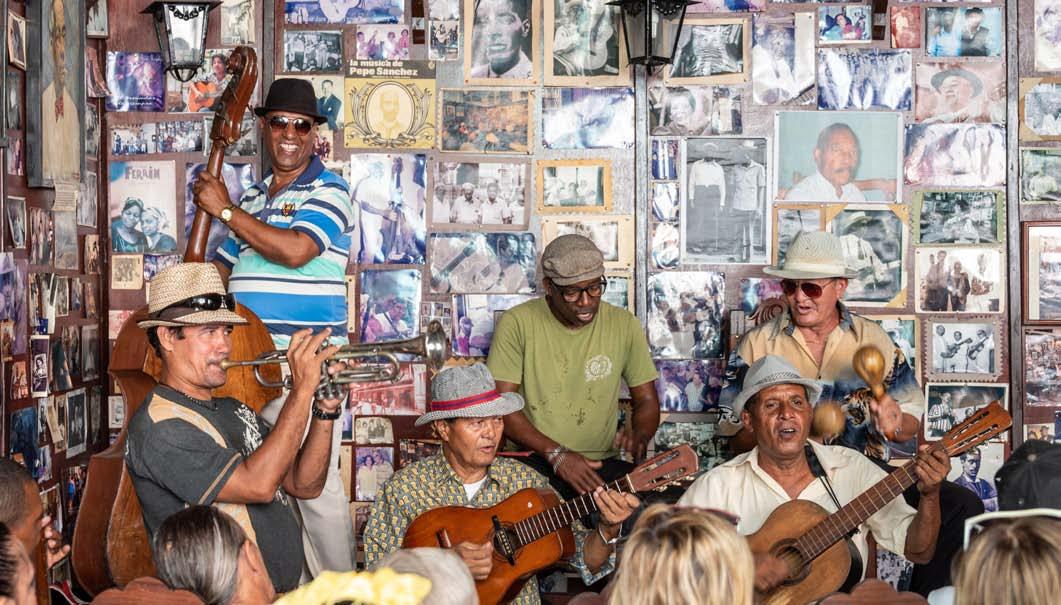
Lovers of Cuban music should not miss the celebrated Festival de la Trova that takes place annually (16–20 March) in Santiago de Cuba.
Santiago city — and the surrounding Oriente Province — are the birthplace of són and its various offshoots, and remain at the heart of this joyous, infectious music.
Trova (I always think of a treasure trove) refers to the body of music produced over the last hundred years or so — originally by roaming musicians,
the Trovadores (Troubadours), who later became more rooted.
During the festival, musicians gather from across the country to perform at a dizzying array of venues that range from dance halls to bars to the tiny Trovita — an intimate space whose walls are plastered with photos of the greats who have played there since its inception.
There are even events in a juvenile prison, and in the Santa Ifigenia Cemetery (where Fidel Castro is buried) in homage to the deceased Trovadores.
Dancing is welcome at all venues —
except, perhaps the cemetery. Though who knows? In Cuba, dance could almost be considered a religion.
Don’t expect much in the way of organisation: Cuban government offices are notoriously bad at this. Consider yourself lucky if you see a programme or schedule of any sort. And if you do, it will be laden with inaccuracies.
But these are minor frustrations, once the music gets underway. Cuban musicians are some of the best anywhere, and Trova is the blood in their veins. It’s an unforgettable experience. n









This March, Netflix premieres a new film on the trailblazing Shirley Chisholm — the first Black woman (who was of Barbadian and Guyanese parentage) to be elected to the United States Congress, and to run for the Democratic Party’s presidential nomination.
Playing Chisholm’s Jamaican husband is Trinidad & Tobago’s own Michael Cherrie.
Caroline Taylor reports

WHEN

Caribbean immigrants have played significant roles in shaping American life and politics. And come 22 March, 2024, Netflix brings to life the pioneering presidential run of one such immigrant — Shirley Chisholm.
Aptly named Shirley, the biographical drama — written and directed by Oscar winner John Ridley (12 Years a Slave) — stars the Oscar, Emmy, and Golden Globe award-winning multi-hyphenate Regina King along with Terrence Howard, Lance Reddick, Lucas Hedges, André Holland, Brian Stokes Mitchell, and Trinidad’s “Black Brando” Michael Cherrie as her first husband, Conrad.
The film depicts Chisholm’s 1972 run to be the Democrats’ presidential nominee. It was announced back in February 2021, with additional casting — including Cherrie’s — revealed in December of that year.
Shirley Anita Chisholm (née St Hill) was born on 30 November, 1924 in Brooklyn, New York to Charles Christopher St Hill (born in what was then British Guiana before moving to Barbados) and Ruby Seale of Christ Church, Barbados. She lived in Barbados from ages five through nine, continuing to identify herself as Barbadian-American through the rest of her life.

She was talented and driven, excelling at school and becoming the first Black woman to be elected to the US Congress in 1968, representing New York’s 12th congressional district in Brooklyn for seven terms (1969–1983). She also became the first woman to run for the Democratic Party’s presidential nomination. She passed away in 2005, receiving the Presidential Medal of Freedom posthumously from President Obama in 2015.
“Growing up in barbados with her grandmother is where she just received a really regimented sense of expectations and strength”
Far too little is known about her for Regina King’s liking, which is in part what makes this film so important. “It was always a little disheartening to have so many people over the years not know who Shirley Chisholm was,” King told Harper’s Bazaar in January. “What she did was so pioneering. She was a true maverick and, you know, we use this term all the time, but she was a true first .”
King also credits Chisholm’s Caribbean roots with who she became.
“Growing up in Barbados with her grandmother is where
she just received a really regimented sense of expectations and strength,” King continued. “That concept of not accepting anything less than the best for yourself was absolutely instilled in her from her grandmother … Also, the schools in Barbados had much more rigorous standards than America. The workload was more intense. By the time she got back to the States, she was so ahead of everyone. She felt such a strong sense of ‘If it’s not me, then who?’”
It’s a sentiment echoed by Cherrie. “I’m really excited to see what the response is actually going to be,” he told Caribbean Beat in early February. “A film about this woman who had the belly to go up against Nixon in ‘72 — never giving up the fight … I think it’s going to expose a whole new generation to this historical figure, the importance of the voting process, having a voice in the political process,” says Cherrie.
It’s also an extraordinary opportunity for him — an awardwinning actor who has been much in demand in his native Trinidad & Tobago, working with some of the country’s and region’s most renowned playwrights, actors and directors — including Tony Hall, Albert Laveau, Rawle Gibbons, and Nobel Laureate Derek Walcott.
He’s also done significant work in both the US and Britain, experiencing a major breakthrough with his casting and performance in the Channel 4 production of Caryl Phillips’ The Final Passage (1996), directed by the renowned Peter Hall (founder of the Royal Shakespeare Company). Cherrie received universal acclaim; Hall compared him to a young Marlon Brando.
But the promise of a burgeoning career in Britain came to a screeching halt when Equity — the United Kingdom’s actors’ union — intervened, working to have Cherrie’s work authorisation denied. They argued he was taking work away from British actors.
Ever philosophical despite his disappointment (he’d been offered roles in Shakespeare productions at the National Theatre and the New Globe), Cherrie returned to Trinidad.
He worked steadily as an actor in local theatre, film, television, and commercials, also becoming a mainstay in international coproductions filmed in Trinidad. His credits include Men of Grey II: Flight of the Ibis (1996); Angel in a Cage (1997, for Canadian television); Danielle Dieffenthaller’s popular soap operas Westwood Park (1998) and The Reef (2007); Merchant/Ivory Films’ production of VS Naipaul’s The Mystic Masseur (2001, directed by Ismail Merchant); Tony Hall and David Rudder’s calypso musical, The Brand New Lucky Diamond Horseshoe Club (in both the US and T&T, 2004–2006); Yao Ramesar’s Sista God (2006); Horace Ové’s The Ghost of Hing King Estate (2009); Limbo (2010, from Norwegian director Maria Sødahl); Home Again (2012) with CCH Pounder and Tatyana Ali; and Maya Cozier’s She Paradise (2020).
In between, he completed a Master of Fine Arts degree at the National Theatre Conservatory in Denver, Colorado; and an undergraduate degree in film from the University of the West Indies — while also continuing to sporadically star in various theatrical productions in the US. What’s more, he still managed to find time to serve as Assistant Professor of Acting at the University of Trinidad & Tobago, a position he took up in 2009.
The Shirley opportunity was an unexpected one for Cherrie, right before his 50th birthday in late 2021. The film’s casting team was looking for a Caribbean actor to play Conrad, who was Jamaican. Cherrie’s management at Question Mark Entertainment (Simon Baptiste and Carolyn Pasea) insisted he audition.
They also shared the opportunity with some of their other clients, all of whom ended up working together in preparation. For Cherrie, that included some acting and dialect coaching sessions, before ultimately landing the role of a lifetime — again.
“All of the principals really welcomed me into their sandbox, and it really meant a lot that someone like the late Lance Reddick was so impressed with my work.” He is full of admiration for all of his co-stars, and also identifies Howard and Reina King (who, along with her sister Regina and John Ridley, is one of the film’s producers) as being prime candidates for enjoying Trinidad Carnival.
International doors have opened and closed for Cherrie in the past, redirecting him back to meaningful work as an actor, educator, and arts advocate in Trinidad. But there’s no escaping the desire to be working regularly on projects of this calibre, on this scale.
for cherrie, that included some acting and dialect coaching sessions, before ultimately landing the role of a lifetime — again
He’s already a member of the American Actor’s Equity Association, with his Screen Actor’s Guild card to follow. And though the debate around non-American actors being cast in American productions continues to rage, the world certainly must have moved on sufficiently in the last 25 years for this never to be a hindrance to Cherrie again.
Most of all, Cherrie says he wants to keep growing. The title of our May 2007 feature on him (available on our website as part of our free, multi-decade digital archive) was “Cherrie blossoms”. There’s little doubt that’s exactly what he will continue to do for many years to come. n

Tree-planting, reforestation, and ensuring the integrity of our waterways are all critical to preserving mangroves — the remarkable forests with the power to protect us from the worst effects of climate change. Erline Andrews learns more
When hurricane Ivan hit Jamaica in 2004, it killed 17 people and caused property damage and losses amounting to 8% of the island’s GDP. Not given as much attention was the storm’s destruction of large parts of the country’s natural environment.
Last July, organisers of a mangrove restoration project in Clarendon gave reporters a tour of coastal areas in the southern parish, including Portland Cottage and Peake Bay. Video and photos from the latter showed what looked like a greyish-brown, barren landscape, jagged tree stumps protruding from the ground — the kind of thing you might see in a dystopian sci-fi movie. It’s what’s left of a vibrant forest.
Years of human and environmental pressures left the Peake Bay mangroves vulnerable to Hurricane Ivan’s battering. In the years following, the area was further ravaged by hurricanes Dennis, Emily, Dean, and Sandy.
“This is a death of a thousand cuts,” Angeli Williams, project manager of
SODECO — the University of the West Indies (UWI)’s Solutions for Developing Countries — told reporters.
SODECO is spearheading the restoration. “After years of different negative impacts on the mangrove, in 2004 — when we had Hurricane Ivan — the area could not recover after that,” Williams continued. “So for the last 20 years, what you’re seeing is a continuous die-off and degradation of this area until it ends up looking like this.” She waved her arm to show the devastation around her.
Jamaica has among the largest mangrove forest coverage in CARICOM (the Caribbean Community). Much of it is in the Clarendon parish on the island’s south coast, within the Portland Bight Protected Area — established in 1999 in part to preserve vulnerable flora and fauna, like sandpipers and other shorebirds.
Jamaica’s mangrove forests — consisting of trees that are adapted to salty water and grow along coasts — are also breeding and feeding grounds for the iconic and endangered hawksbill turtle and other animals, including 220 species of fish. Some of them, like mackerel and
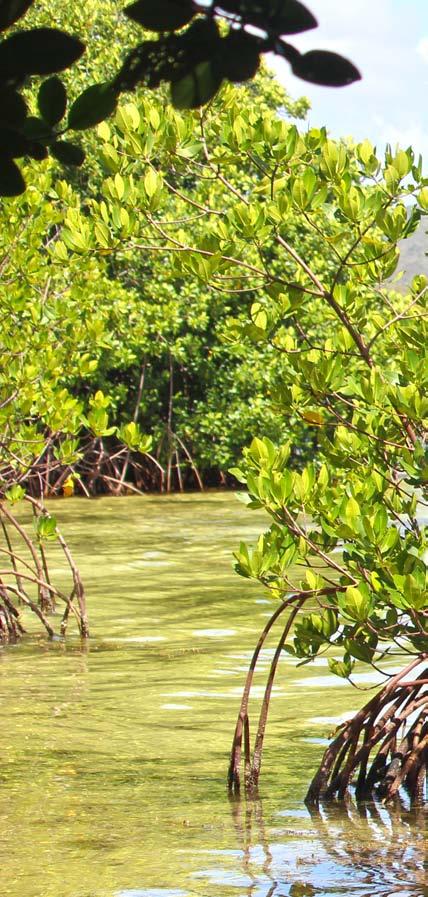
snapper, are important to the livelihoods of fisherfolk.
And there’s still a lot to be discovered about mangroves. In 2022, it was reported that scientists found the largest bacterium, Thiomargarita magnifica or “sulfur pearl” — the size of an eyelash — in the mangroves of Guadeloupe.
In an age of increasingly damaging effects from climate change, mangroves perform two key functions. They sequester harmful carbon dioxide from the atmosphere, holding it in the soil with their dense root system and in their biomass — the trunks, branches and leaves; and they provide protection from storm winds and flooding.
Both services are worth potentially hundreds of millions of dollars if Jamaica were to monetise the mangroves’ sequestered carbon through blue carbon credits, and because of reduced costs from loss and damage caused by hurricanes.

But of course the most important thing is that they keep people safe.
Ann Harvey, the owner of a preschool on Union Island in the Grenadines, told the BBC of her experience anxiously watching from home during Hurricane Ivan.
“I stood in a corner, just staring, concerned that the [school] roof would be blown away. But then I noticed something,” she said. “The mangroves were taking the brunt of the storm, protecting the school. For hours, they swayed in the wind and big waves crashed into them. Some of them eventually broke away, but nothing happened to the school.”
The mangroves that protected Harvey’s school were a small batch that remained from the forest at Ashton Lagoon that had been destroyed by a hotel construction project a decade before Ivan. The forest was restored in 2018 with the planting of more than 3,000 seedlings, and today is an attraction for tourists and locals alike.
“the mangroves were taking the brunt of the storm, protecting the school. for hours, they swayed in the wind and big waves crashed into them. some of them eventually broke away, but nothing happened to the school.”
Other successful restoration works in the region include the Ma Kôté mangrove forest along the southern coast of St Lucia — the largest mangrove forest in the eastern Caribbean. Parts of it were salvaged six years ago by planting around 4,000 trees with the involvement of more than 400 schoolchildren.
Restoration of Bonefish Pond National Park in The Bahamas started in 2008 with the clearing of mounds of trash and other discarded debris, and is ongoing.
“Mangrove planting has become one
of the most popular and trending conservation activities,” Elijah Sands of The Bahamas National Trust — caretakers of the park — writes in his blog, where he shows some of the more than 10,000 photos he took of tree-planting events over the years. “This means people are always reaching out wanting to plant mangroves.”
His favourite event, he writes, was the one where participants drank beer, planted trees, and kayaked to commemorate World Oceans Day 2021.

The Inter-American Development Bank, which provided funding for the Clarendon project, is also funding mangrove restoration in Suriname’s Bigi Pan Multiple Use Management Area — a protected area on the country’s northwest coast.
Jamaica started a series of restoration projects in 2008, largely under the guidance of Professor Mona Webber and the team she heads at UWI’s Centre for Marine Sciences. They have established two mangrove nurseries that can produce up to 20,000 seedlings. But often planting isn’t necessary, Webber explained in a TED Talk last year.
“In many cases, our approach simply requires removing blockages to water flow,” she said. “These blockages can include mounds of garbage compacted over many years in the forest, wood, downed trees from hurricanes, and marl — construction material! — dumped in
the middle of a mangrove forest in order to reclaim land, usually for squatting.”
The Clarendon project is the most ambitious mangrove restoration project ever attempted in Jamaica, and possibly the English-speaking Caribbean. It aims to rehabilitate more than 1,600 hectares of mangrove. Webber pointed out in the TED Talk that the project, which she’s involved with as a consultant and a member of the steering committee, could increase Jamaica’s mangrove cover by nearly a third. “I’m really looking forward to this,” she added with a smile.
SODECO was founded in 2012 by medical scientist Professor Terrence Forrester, who that year had been honoured with the Order of Jamaica for his contribution to medical research. He had led the formation of UWI’s Caribbean Institute for Health Research.
SODECO’s current focus is on health problems related to poverty. “The environment and we people occupy a single indivisible ecological space,” Forrester explained via email. “Human health, wealth, and well-being unfold within this single ecosystem.”
He also explained the origins of the Clarendon project. “The hurricanes in 2004 and 2007 were the straw that broke the ecological camel’s back, and precipitated the mass die-off of mangroves along the Clarendon coast … We accepted the problem as something that had to be addressed, and set about tackling it by raising funds and acquiring expertise.”
An assessment of Peake Bay showed the channels that brought and removed sea and fresh water to the area are blocked.
SODECO plans to reopen the channels and introduce fresh water provided by mining company Jamalco. There’s no need for planting seedlings at Peake Bay, said Angeli Williams. They expect healthy trees on the edge of the dead area to propagate it once the hydrology is fixed.
“We’re aiming for natural regeneration,” she says. “We don’t have an endless budget so we have to act smarter.”
In Jackson Bay at Portland Cottage, they built a culvert across a roadway to restore the hydrology there. Baseline assessments and community consultations have been done in other areas as part of the decision-making on how to restore the other dead or dying forests.
The project will be a long-term endeavour. So it is with successful mangrove restoration. “We are not saying that the first move we make is going to be perfect,” said Williams. “But what we are saying is that we will do continuous monitoring so that we can adjust our interventions so that we can get the best possible outcome.” n





These travel influencers share their favourite things about Easter time across the Caribbean — as told to Shelly-Ann Inniss



My first visit to St Lucia was at Easter, and I remember being blown away by the beauty. To be on the beach and see the Pitons in the background seemed so surreal. Also, as someone who loves the outdoors, I climbed to the top of one of the Pitons, then spent the rest of the day on Sugar Beach with lunch at Jade Mountain.
One of my favourite things to see during Easter is kite-flying, and while there, I saw quite a few kites being flown. It was wonderful to know that this tradition is still practised across the Caribbean.
I love any version of accras or fish cakes (saltfish fritters), and we had plenty of those to eat. If you are driving through the island, you will definitely spot people on the way to church wearing Easter hats — that was very beautiful to see. St Lucia is the gift that keeps on giving and remains one of my favourite destinations.
c indy a llman (@bookofcinz) is a book blogger, reviewer, book club host, and content creator who has travelled to dozens of countries (and counting!)



I’m usually at home in Barbados for Easter, and recently I had a really lovely staycation on the east coast. It was super relaxing and refreshing.
The place where I stayed offered a nice variety of dishes at their restaurant — like plantain French toast, lobster benedict, and crispy fish sliders — from their seafood and plant-based menu.
Fish is the first choice for most Bajans at Easter, so I also visited the Oistins Fish Festival — a great local Easter tradition where you can enjoy local cuisine like fish cakes and grilled fish; arts and crafts from vendors; fun competitions and great entertainment.
After the Easter celebrations, I visited Grenada and enjoyed their annual Chocolate Festival. I learned so much about their topquality chocolate and rich spices. I never knew there were so many amazing ways they can be used!
samantha g ittens (@oraclesam) is a digital creator from Barbados with a passion for exploring new places, trying new foods and products while creating engaging, exciting content
Fresh fish is offloaded at the jetty and enjoyed at the oistins Fish Fry just a stone’s throw away



The Easter holiday season is all about family and church in Jamaica. This is also the time of the year that we can consume a lot of spiced bun-and-cheese along with fish.
Most Jamaicans (myself included) would roam the countryside of Jamaica — Clarendon in particular for me — to enjoy family time. This is something I enjoy thoroughly. The hills of Clarendon are cooler in temperature at this time, so I often look forward to seeing everyone and eating some of the best fried fish for Easter.
Church is a staple during this season — from Holy Thursday right back to Palm Sunday. Catch me there on Easter Sunday. Growing up with my grandparents, attending church on this day is a must.
Easter Monday is a major holiday in Jamaica, where locals flock to the beaches. My family and I make this an annual ritual. I keep it very traditional during the Easter season! I’ll take church, the country life, family time, bun-and-cheese and fish anytime!
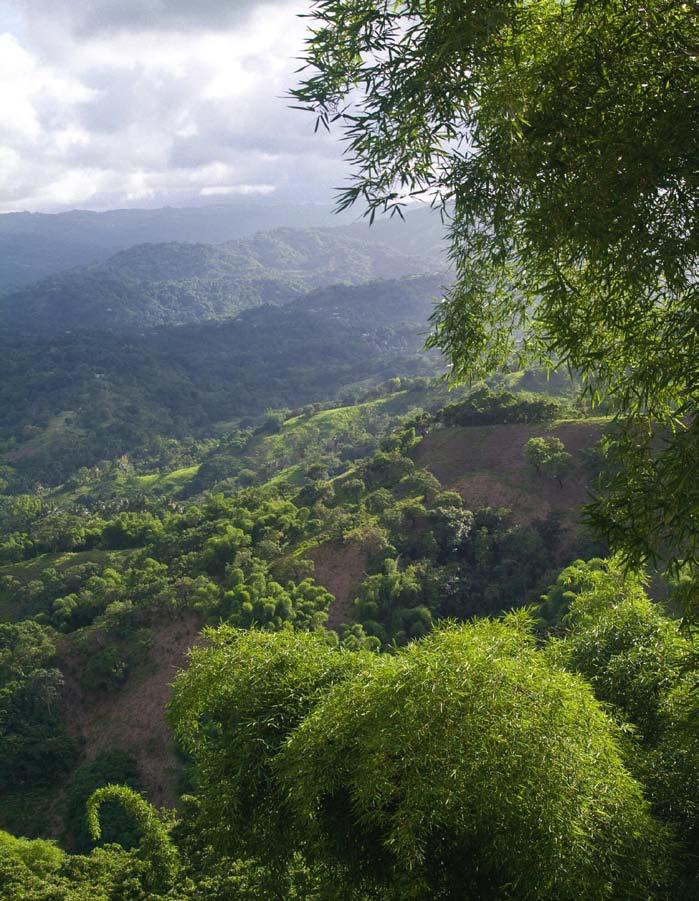
s hea Powell (@TheWorldUpCloser) is a travel adventurer and digital content creator who runs theworldupcloser. com. She has travelled to over 45 countries so far
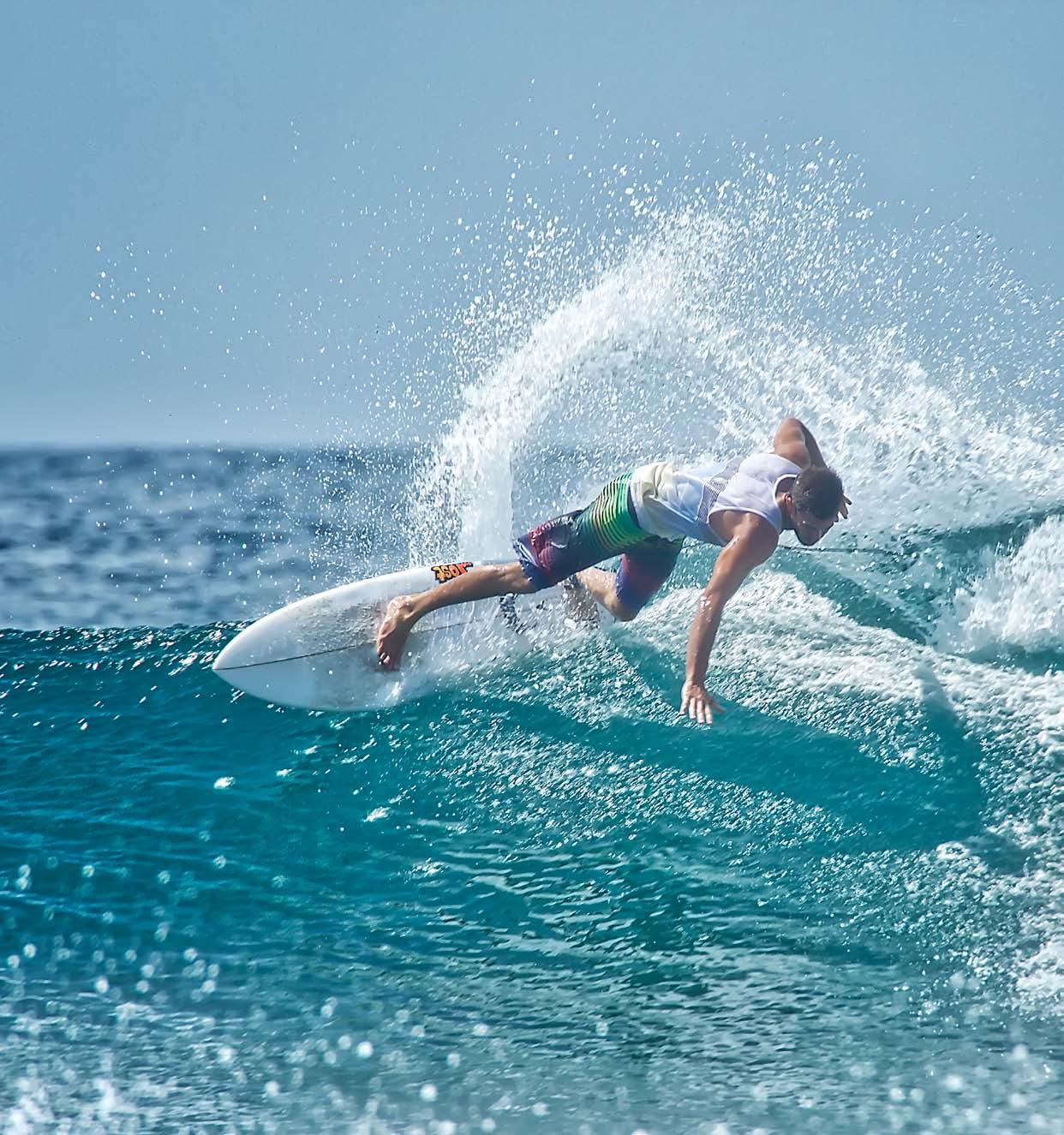


Anytime is a good time to visit Tobago for me. This was especially true during the many years that my dad, a born and bred Trini from San Fernando, lived there in retirement. I visited often, experiencing Tobago’s charms at various points of the year.
My favourite time to be in Tobago, though, is definitely Easter. The island really comes alive as droves of people from the island and from neighbouring Trinidad enjoy the beachy vibes and uniquely Tobagonian Easter festivals. The highlight is undoubtedly the goat races in Buccoo, or more to the point: the post-race fete.
Aside from liming with my dad and enjoying an ice-cold beer and a big bowl of crab-and-dumpling from Miss Trimm’s, my favourite memories must be of surfing. Actually, I should say trying to surf.
Most people don’t think of Tobago as a surfing hotspot. An Easter weekend visit to Mt Irvine Beach will make you think differently. A nice break off the north shore of the beach made for some steady waves during my visit. I took a lesson that didn’t really end well, but it definitely has me anxious to get back for another try (and more crab-and-dumpling) soon.
stephen b ennett and his brother Patrick are committed to sharing authentic aspects of Caribbean life and culture via UncommonCaribbean. com and @UncommonCarib. They’ve visited more than 50 destinations, with Steve continuing to fail at surfing …
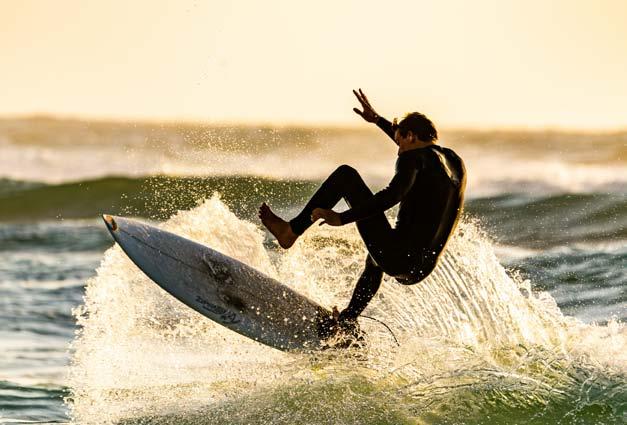


Accessible via direct flights from either Dominica or St Lucia (and, very soon, with direct connectivity on Caribbean Airlines), Martinique is a must-visit. And Easter in Martinique is such a joyous time.
I didn’t expect to exchange Easter egg hunts and chocolate bunnies for eating crab — loads of it. Eating crabs — also known as matoutou — on Easter Monday is to Martinique what eating turkey is to American Thanksgiving.
I was determined to get my hands dirty to prepare this delicacy. The smell of citrus filled the air as over 100 crabs doused with water and oranges waited in a tub in my friend’s back yard. Before I knew it, the smell of oranges was replaced by the aroma of peppers, bay leaves, and garlic as the sauce began to boil.
My self-control was tested when we left the crabs in the giant pot to marinate. We joined over 30 members of my friend’s family for lunch, but I’m not sure who was more anxious for us to arrive.
I’ve experienced Easter in many different parts of the world, but I’ll never forget my first Easter in Martinique.
francesca murray (@onegrloneworld) is an award-winning journalist specialising in beauty, travel and lifestyle advice; the editor-in-chief of One Girl One World; and one of the pioneers of the Black travel movement


on the western bank of the Suriname River, with an old Dutch fort at its heart, Paramaribo surprises many first-time visitors with its friendly, sophisticated vibe. The relatively compact historic centre is easy to explore on foot and full of unexpected pleasures — perfect for exploring in a free afternoon or weekend break
Even the briefest stay in Suriname’s capital reveals its unexpectedly cosmopolitan charms. Here’s how to make the most of Paramaribo when time is tight

Suriname’s ethnic diversity means Paramaribo is a culinary cornucopia. By all means try its Creole, Chinese, Indian, Brazilian, and other restaurants — and don’t miss the chance for a lavish Javanese meal. There are warungs — traditional restaurants — scattered across the city, but head for the northern neighbourhood of Blauwgrond, where numerous family-run warungs offer dishes like gado-gado and satay in unpretentious surroundings.

onafhankelijksplein — that mouthful is Dutch for Independence Square — is the biggest green space in the centre of the city, but a stone’s throw from its manicured turf you’ll find the Palmentuin, a small park planted entirely with towering palm trees. It’s a tranquil, vertical green space that gives a hint of the vast forests in Suriname’s interior.

Is there anything more Caribbean than a trip to the beach? when Surinamese are ready for a swim, they don’t head to the sea — rather, they turn inland to Colakreek, a freshwater bathing spot with waterslides and camping facilities. The name comes from the naturally dark-tinted water, which does indeed look like Coca-Cola — perfectly clean, but stained by the tannins from forest leaves.

If Paramaribo is one of the Caribbean’s prettiest cities, that’s thanks to its traditional architecture, recognised by uNESCo and relatively well-preserved in the streets and squares closest to the river. Built of wood (on brick platforms), with balconies and classical columns, these heritage buildings are almost uniformly painted white with dark green trim.

As the day ends and the sun dips below the horizon, Paramaribo’s most atmospheric spot just might be the waterkant, the terrace running along the riverfront. Take a friend, buy a djogo (litre-size bottle) of Parbo beer, find a bench, and enjoy the spectacle of dusk settling over the river.
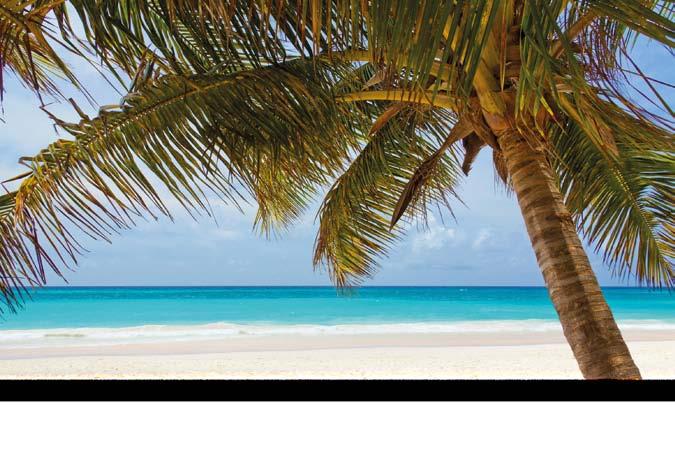
Lowlands
Lowlands Mall,
Piarco Plaza, Trinidad
Piarco Plaza, Trinidad #15
Trinidad
#15 Ariapita Ave, Trinidad
Duncan Village, South Trinidad
Duncan Village, South Trinidad
Hearthland Plaza, Central Trinidad
Hearthland Plaza, Central Trinidad








A century ago, the United Kingdom staged a massive colonial exhibition, aimed at being a lavish demonstration of imperial grandeur, might, and “family unity”. It was meant to send a signal to rival colonial powers, and to boost morale at home. But, writes James Ferguson, none of it would turn out quite as organisers hoped
Photography by Chronicle/Alamy Stock PhotoOn 23 April 1924 — 100 years ago — King George V officially opened the British Empire Exhibition in Wembley, London. A shortened version of his speech travelled around the world by telegram to every part of the empire, and was returned to him within 80 seconds by a messenger boy. It was considered a triumph of modern communications technology.
The exhibition itself was intended as a demonstration of imperial grandeur. Covering 216 acres, the site had been under construction since January 1922, when work began on Wembley Stadium — a massive sports arena that could accommodate 125,000 spectators. The ground was finished in time to host the FA Cup final in April 1923 between Bolton Wanderers and West Ham, and the king was present to award the trophy to the winning team.
The rest of the exhibition was clustered around the stadium, and comprised buildings intended to house the exhibits of the individual colonies and dominions that made up the empire. The government had settled on the opening date back
in 1919 when funding was secured, and a large building site began to take shape as the deadline approached.
Wembley was seen as the ideal venue, as parts of the suburb were still undeveloped, and it was close to central London with good transport links. There had been previous such events at White City and Crystal Palace, but these were not considered big enough. Size was important, as the exhibition was meant to project Britain’s role in the world, its “family” of colonies and dependencies, and its economic might.
There was a competitive edge as well. France and Germany were colonial rivals that had organised similar exhibitions, and Britain — exhausted and almost bankrupted by the Great War (World War I), which had ended only five years previously — wanted to boost domestic morale and make a spectacular statement about its global future.
In fact, the future of the empire looked far from secure. India was pressing for self-government; Canada was looking to increase its autonomy; and there were increasingly militant anti-colonial movements around the world. Many colonies
had sacrificed huge numbers of men during the war, creating deep-seated resentment, while revolution in Russia seemed to offer an alternative to the old world order.
The Caribbean colonies shared this general sense of restlessness. Political leaders such as Jamaica’s Norman Manley served in the British Army during the Great War, and were aware of the racism that many West Indian volunteers experienced. A new generation of political activists including the Trinidadian CLR James were inspired by events in Russia and by the anti-colonial revolution in Haiti.
A long period of imperial neglect and economic decline had blighted the British-ruled islands and mainland territories, and this would get worse with the impending Depression and turbulence of the 1930s.
But if enthusiasm for the “motherland” and the exhibition was muted among some colonial subjects, it was embraced by the vested interests in the region. The West India Committee, a body representing British economic interests that had evolved out of the old slave-owning plantocracy, was keen to raise the Caribbean’s profile at the event. Its officers worked hard with colonial authorities, local businesses, and British-based companies to arrange the participation of every territory.
The exhibition’s prospectus made clear that its purpose was above all an exercise in marketing:
It will be in effect an imperial stocktaking and a vast window display.
Those who doubt the empire’s potentialities, and those who simply do not consider them, will be confronted with a clear sight of what this great community of free nations can produce.

The “vast window display” took the form of Wembley Park, a specially designed conglomeration of buildings meant to reflect the architecture of the cultures represented. Alongside “palaces” devoted to engineering, industry, and the arts were “pavilions” containing the exhibits of different territories — a huge Indian Taj Mahal-inspired edifice of domes and minarets; a Burmese temple; and a Maltese castle with an imitation Mdina Gate, all made with reinforced concrete.
The West Indies and British Guiana had a strange cohabitee in the shape of the Falkland Islands, and were housed in a pseudo-Georgian building that had nothing to do with Indigenous architectural traditions. According to Tom August, its “restrained facade with green shuttered windows and covered with a red tiled roof surmounted by a clock tower with an illuminated dial signified only a British aesthetic”.
Visitors to the large exhibition space passed statues of Columbus and Admiral Rodney before walking around gangways that linked the different Caribbean exhibitors.
Paying a fee according to the size of their stand (Jamaica’s was the largest), the colonies showcased their commodities: bananas, sugar and rum (Jamaica), limes (Dominica), spices (Grenada). Only
Barbados emphasised its tourist industry, while Trinidad & Tobago prioritised Angostura Bitters over its booming oil industry. Its refreshment room, serving hot chocolate, was one of the exhibition’s successes, as was Jamaica’s Planters’ Punch Bar, admired by visitors such as Ian Fleming and PG Wodehouse.
In his article “The West Indies Play at Wembley”, Tom August remarks:
Trapped in images created by empire, the West Indies exhibit tantalised Bertie Wooster and the rest of the metropole with the prospect of playing planter in an Anglo-Saxon tropicana.
Images of the various Caribbean exhibitions have been collected in the Brent Archives, and they look like a collection of boutique delicatessen counters, all tastefully decorated with tropical plants and colourful handicrafts. In one photograph, the king and his entourage stroll through a crowded hall, with palm trees evoking the attractions of Tobago.
One interesting image is a group photo of “the people who ran the West Indian Pavilion”. Of 50 or so smartly dressed individuals, there are maybe five who are not white. The apparent exclusion of the Caribbean’s more mixed cultural heritage
one of the posters advertising the 1924 British Empire Exhibition
stood in contrast to some of the African colonial exhibitions, where people were brought to London as human exhibits demonstrating crafts and dancing — a feature criticised by West African students in London as perpetuating primitive stereotypes.
Although the exhibition attracted 25 million visitors in total, it was a financial flop and it was decided to extend the event between May and October 1925 to reduce its losses. Grenada and St Lucia decided to close their stands, but the other exhibitors
remained in place until the official closure, when the pavilions and palaces were dismantled and demolished. Only Wembley Stadium, with its iconic pseudo-Moghul twin towers, was preserved — only to be demolished in 2003 in a radical reconstruction of the stadium.
The British Empire Exhibition was intended to stress the unlimited economic power of a vibrant imperial network, with Britain at its centre. Visitors were amazed by the profusion of goods and cultures on show and were encouraged to buy colonial produce, invest in colonial businesses, and even migrate to the vast and fertile lands of British Guiana.
But impressive though it was as a logistical exercise, it was ironically significant as one of the empire’s last hurrahs. Financial crisis and another global war fanned the flames of anti-colonial feeling, and what Harold Macmillan (Prime Minister of the United Kingdom, 1957–1963) would later call the “wind of change” became an unstoppable force.
Within three decades, the ideas celebrated in Wembley’s mishmash of exotic exhibits already seemed irrelevant. All the more so a century later now that India’s economy has overtaken Britain’s and the proudly independent nations of the Caribbean reassess their relationship with the former colonial power. n
Across
1 Cooks hot cross buns, in a way [5]
4 Reproduce plants by cuttings or grafts [9]
8 Paired with spaghetti [9]
9 Convey knowledge [5]
10 Hostility, ill will [6]
11 Non-electric music [8]
12 Roaming musicians at Festival de la Trova [10]
14 Hotel’s offering [4]
18 Major metropolitan area [4]
19 Shore birds [10]
21 Place to get taxis [8]
23 Religious or ordained minister [6]
26 Hermit crab’s protection [5]
27 Rolled tortilla dish [9]
28 Passing critical remark [9]
29 Entertains guests [5]
Down
1 Pompous, sickening [9]
2 Type of casual pants [5]
3 Unfit or unsuitable living conditions [8]
4 ___ Sunday [4]
5 Film director with a distinctive style [6]
6 Miles ___ [5]
7 Moral stance [5]
13 Granola bar crumb [3]
15 Modestly supplying a poem [3]
16 Singers, pianists, drummers [9]
Spot the Difference by gregory St Bernard

17 Fish with elongated spear like or swordlike upper jaw [8]
20 What are the stems of plants? [6]
21 They hold rum [5]
22 Loaf in the kitchen [5]
24 Potholes’ places [5]
25 A sizable plot of land [4]

There are 15 differences between these two pictures. how many can you spot?
has a different hairstyle; -pur ple fish has longer tailfin; eyebrow fish now has a bandanna; gold and magenta Easter egg has different colour pattern; fish with glasses is wearing a different hat; fish with glasses is red; crab is light blue; bottom
Yellow fish has a different facial -expres sion; yellow fish is now holding an Easter egg; fish with golden egg has its main colours swapped; bed of seaweed has an additional weed; bed of seaweed is a different colour; eggs stored in bed of seaweed are unpainted; blue fish (middle left) is holding a green Easter egg; blue fish (middle
Word Search
by www.sudoku-puzzle.net
Fill the empty square with numbers from 1 to 9 so that each row, each column, and each 3x3 box contains all of the numbers from 1 to 9. For the mini sudoku use numbers from 1 to 6.
O H U A U P T M 8 E A T B A L L S T 9 E A C H B K H M E R I A 10 N I M U S A 11 C O U S T I C S M R T 12 R O 13 V A D O R E S R 14 O 15 O M 16
I A N B 17 D U C 18 I T Y S 19 A N D P I P E R S S 20 L I C 21 A B 22 S T A N D C 23 L E R 24 I C A R A A 25 F O I S 26 H E L L E 27 N C H I L A D A K A K R S D N S 28 I D E S W I P E H 29 O S T S R U N F O R G E T T A B L E K E S E Q U E S T E R Q I N A D S T M G N I L P M U D M Y X A T C A A C G B D Y C N A F E N O H C V H O G E M K K N R X C R O K O U V U T A O G G U P I A C E N R E H N J C C R S E N T O R A C R A T T L H O T R G I L E S H N M R A R J V R T N O A L S S M L R O M Y E A I I N T U O I E E N T M E S T S N F E C B F N T J D N A M I E I R V K B D T S P I C E S O D M U A Y O R A N G E S V T N R E S W N U H L L I B S K W A H Y
mining fish expertise surf hamlet tent dumpling countryside chocolate oranges aroma memory wave spices fancy Caribbean Crossword Caribbean Beat Magazine
6 4 8 3 9 2 1 7 5
5 1 7 8 4 6 9 2 3
9 3 2 5 7 1 4 8 6
7 5 6 9 2 4 3 1 8
4 8 1 6 3 7 2 5 9
3 2 9 1 8 5 6 4 7
8 7 4 2 6 3 5 9 1
1 9 3 4 5 8 7 6 2
Sudoku 2 6 5 7 1 9 8 3 4
Beat Sudoku 9x9 - Solution 5 of 5 - Medium
www.sudoku-puzzles.net Caribbean Beat Magazine
www.sudoku-puzzles.net B 1 A K 2 E S 3 P 4 R O P A 5 G A 6 T E 7
6 3 5 4 1 2
4 1 2 3 6 5
2 5 3 1 4 6
1 6 4 5 2 3
3 2 1 6 5 4
5 4 6 2 3 1
Sudoku 6x6 - Solution 1 of 5 - Easy








games and more Caribbean
Content The NEW way to be entertained!



Troubleshooting
Unable to connect
1. Switch Wi-Fi off and on
2. Power the device off and on and repeat step 1
Unable to view content
1. Close and restart the browser and type www.caribbean-airlines.com
2. If this does not work, try an alternate browser and type in www.caribbean-airlines.com
3. Power the device off and on and try steps 1 and 2 again
Note: Chrome is the recommended browser for laptops.
By using the system, you accept the following terms and conditions:
• *Content is available only on flights over two hours.
• Content is available only during flight.
• Access to content is only available above 10,000 feet.
• Access to content will stop before the end of the flight
• You may not have sufficient time during the flight to watch the entirety of some content.
Viewing information:
Please choose your viewing appropriately Note: Some content may not be suitable for younger viewers, so please choose appropriate content where children will be watching
Please ensure headphones are used at all times for playback of media content, unless muted.

Enjoy
• It may take a short time for a video or other content to start.
• Please note that we are not responsible for any data loss or damage to devices that may occur while/after using our services.
• Onboard battery charging facilities are available.
Safety information:
• We may pause or stop our inflight entertainment system for safety or other reasons.
Security information:
• This service is provided using wireless LAN technology Please be aware that it is a public network.
Fort Lauderdale
 GRAND CAYMAN
Dominica
Curacao
Ogle
Caracas
St Kitts
GRAND CAYMAN
Dominica
Curacao
Ogle
Caracas
St Kitts
Across the Caribbean, the glorious dry season weather — bright and breezy (if not also hot and dusty) — makes kite-flying a popular pastime around Easter. From organised competitions like the Jamaica International Kite Festival to informal displays in neighbourhood parks, colourful confections of paper and string take to the skies.


Choosing a 4x4 vehicle just got a lot easier. Because nobody but Jimny offers such a superbly balanced combination of authentic off-road ruggedness and light, nimble, manoeuvrability. What’s more, the new 5-door model gives you expanded carrying capacity and truly comfortable seating for four adults. Scan the horizons and you will see - there is nothing else like it on Earth.
Visit www.suzukicaribbean.com
